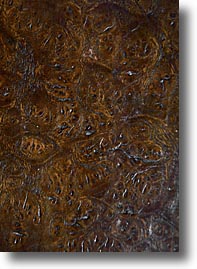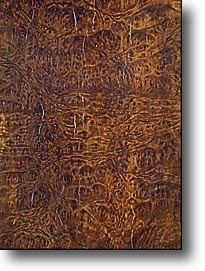 Burls are abnormal projections that bulge out from or encircle the trunks or branches of trees. What causes them remains unknown and their tumor-like growth does not appear to adversely affect the tree's health. Various theories suggest that they result from falling trees, fire or frost damage, invading fungus or bacteria, or even woodpeckers. Certain species, such as camphor, elm, nanmu, cypress, and willow also seem to be more susceptible to burl growths.
Burls are abnormal projections that bulge out from or encircle the trunks or branches of trees. What causes them remains unknown and their tumor-like growth does not appear to adversely affect the tree's health. Various theories suggest that they result from falling trees, fire or frost damage, invading fungus or bacteria, or even woodpeckers. Certain species, such as camphor, elm, nanmu, cypress, and willow also seem to be more susceptible to burl growths.
The wood tissue of a burl is extremely disoriented and is comprised of many small bud formations that often appear as clusters of round curls. It is often difficult to distinguish one burl species from another. However, similar coloring, texture, and grain patterns of the parent tree can often be detected.
 Nanmu burl is often described as having a "grape seed pattern," which describes the tiny seed-like bud formations within it. Such burl may also come from the roots of massive nanmu trees. Wood from the junction of the trunk and roots is full of interesting and distorted figure caused by the changes in direction of the wood fibers as they branch out as roots, and by the effects of compression from bearing the weight of the tree.
Nanmu burl is often described as having a "grape seed pattern," which describes the tiny seed-like bud formations within it. Such burl may also come from the roots of massive nanmu trees. Wood from the junction of the trunk and roots is full of interesting and distorted figure caused by the changes in direction of the wood fibers as they branch out as roots, and by the effects of compression from bearing the weight of the tree.
Burl-like figure also frequently develops in several varieties of birch (huamu (Betula)) that grow throughout China. The heartwood is generally light yellow and sometimes figured with rust-colored 'bird's-eye' or striped patterns. In Chinese, the term huamu is used interchangeably for birch and birch with burl-like figure, as well as for burls in general.
Extract from:
Evarts, Curtis. C. L. Ma Collection: Traditional Furniture from the Greater Shanxi Region, 1999.
